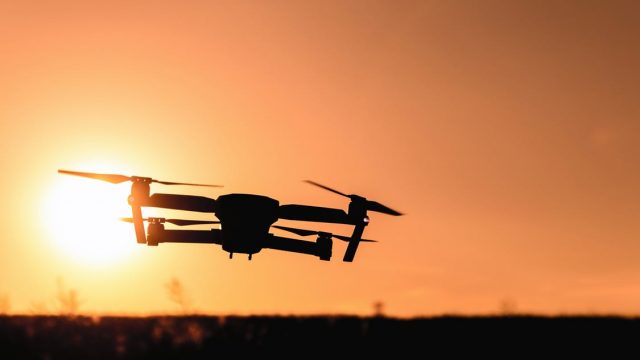
You may not see it happening yet, but drones are already changing everything. They’re searching woods for lost hikers, surveying land and crops, catching poachers, inspecting infrastructure, locating forest fires, and even catching criminals. We race them and snap photos with them. In the near future, they’ll walk our dogs, respond to our medical emergencies, and transport our cargo. And they’re revolutionizing innumerable other fields of work.
Drones’ abilities will cause some of our jobs will disappear, of course. But their net benefit to humanity seems substantial, and scarcely a day goes by without a news article praising their potential to aid us in our work.
But drones are revolutionizing every sector of the economy—not just the legal ones. And there’s been far less discussion about drones’ potential to aid criminals in their work.
Using drones for crime hasn’t caught on in a big way yet, but drones are undergoing changes that will make them far more useful to criminals than the clumsy quadcopters we use now.
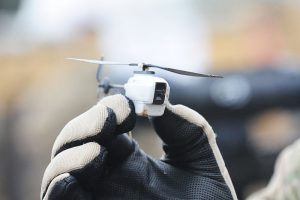 Drones are getting smaller. Various militaries are already using drones the size of a dragonfly, and it’s only a matter of time before this miniaturized tech hits consumer shelves.
Drones are getting smaller. Various militaries are already using drones the size of a dragonfly, and it’s only a matter of time before this miniaturized tech hits consumer shelves.
They’re also becoming more powerful, able to carry objects, and can stay afloat for extended periods of time, recharging their batteries with solar power. With the emergence of ubiquitous 3D printers, drone components will become far cheaper and easier to create at home. And at some point, drones will become so quiet we won’t be able to hear their buzzing.
Because of these changes, the use of drones in the near future will be even more anonymous. Law enforcement will have a much harder time tracking who is using them.
What might criminals use this technology for in the coming decades?
Privacy’s End
Drones’ impact on privacy might start small, with more surveillance drones—both official and unofficial—patrolling our streets. Imagine constant armies of prying journalist drones hovering outside the houses of public personalities. Students could cheat on tests by using their bee-sized drones to peek at another student’s work.
 Then we might find drones peeking over our shoulders as we type our PIN numbers at cash registers and ATMs. Once criminals have collected enough personal information this way, they could empty our bank accounts and 401(k)s. Identity theft would run rampant.
Then we might find drones peeking over our shoulders as we type our PIN numbers at cash registers and ATMs. Once criminals have collected enough personal information this way, they could empty our bank accounts and 401(k)s. Identity theft would run rampant.
Rival businesses may use drones to spy on each other’s board meetings, stealing each other’s trade secrets. If so, new startups wouldn’t stand a chance, since entrenched businesses would instantly learn their advantages and copy them.
Stalkers might use drones to pursue their victims relentlessly, taking countless photos and videos of them. In fact, drones will be so small and undetectable that an unsettling possibility presents itself: no sex act will be private in the future. It’s conceivable that at any time, a criminal might be recording us in our most intimate moments, perhaps for entertainment, perhaps to extort us. A quick internet search might reveal lewd videos of literally everyone as underground drone porn takes off.
Through drones, any criminal, any government, any corporation, or any person off the street might be able to see our credit score, our medical history, who we vote for. With a small scratch from a bee drone, anyone could collect our DNA at any time.
Even without taking governments’ invasions of our privacy into account, the world of drones could very well be a world with no secrets.
Untraceable Crime
 Drones are already being used to smuggle contraband into prisons, but they could be used to smuggle much more: illegal drugs, human organs, antiques, and once drones that can lift hundreds of pounds becomes widespread, people. Any point above the airspace of any border would be vulnerable to such trafficking. Buyers of illegal drugs would never have to meet dealers. Instead, their drones could simply meet to make each exchange.
Drones are already being used to smuggle contraband into prisons, but they could be used to smuggle much more: illegal drugs, human organs, antiques, and once drones that can lift hundreds of pounds becomes widespread, people. Any point above the airspace of any border would be vulnerable to such trafficking. Buyers of illegal drugs would never have to meet dealers. Instead, their drones could simply meet to make each exchange.
Imagine states or cities using bee drones to surreptitiously dope a key athlete on their opponent’s team, disqualifying the athlete from a sporting event. In fact, anyone could be dosed with any drug for any purpose: marijuana, heroin, date rape drugs.
Criminal communications networks borne on the backs of drones might spring to life one minute and vanish the next. Every store and private property would become more vulnerable to theft. Even a quadcopter drone could quickly zip onto the property, snatch its target item, and make a quick escape. Vandalism, too, would become much easier with drones. Bee drones could navigate through air vents to target the interior of a building while larger drones target the exterior.
Drones might even be used in muggings and hostage situations. A drone armed with a gun could hold anyone under duress while the perpetrator remained safe miles away. And despite drones’ use to stop poaching, poachers could also use drones to auto-kill their target animals on sight, geotagging their bodies for later pickup.
As a matter of fact, experts are concerned that armed drones with the ability to auto-kill their targets could lead to some truly dystopian scenarios…
Mass Assassinations and Invisible Wars
 Perhaps the most alarming class of crime that drones could empower is war crimes.
Perhaps the most alarming class of crime that drones could empower is war crimes.
Combat drones alone have already caused significant controversy: When killing is so detached and impersonal, does it psychologically cheapen war? Can we hold our leaders accountable when so much of modern warfare is witnessed by so few people?
These questions will become even more potent in the era of autonomous warfare. It’s been a decade since the U.S. military began developing the ultimate stealth weapon: tiny drones capable of sneaking up behind an enemy combatant and killing him with a single shot to the back of the head. And now the race is on among China, Russia, and the United States to make these drones autonomous. The goal of autonomy is to program these drones with an enemy profile—maybe a face, a place of residence, maybe a gait or olfactory profile—and send the drone to complete the assassination alone, with no human interference necessary.
Swarms of hundreds, or even thousands, of autonomous killer drones could potentially wipe out entire cities within minutes. The U.S. Department of Defense has been testing drone swarming capabilities that would allow relatively few perpetrators to slaughter a great number of victims. If strong global transparency laws aren’t in place by the time this research bears fruit, millions could conceivably be killed, and we may never know why. We may never know who is responsible. For the next Pol Pot or Idi Amin, genocide would become possible with the flick of a switch.
This technology will also cause a domino chain of unintended consequences, memorably illustrated in a brilliant short film by the Campaign to Stop Killer Robots. In the film, autonomous kill drones developed for the military find their way onto the black market. Once the technology exists, it only takes one person leaking its specs online for the entire criminal world to have access to it.
Criminals with the Power of States
Most people are decent people who would never think of using tiny weaponized drones for murder. But there is a small subset of people who would. And policing them would be extremely difficult, because almost no evidence would be left at the crime scenes. In most cases the drone itself would escape, leaving only a bullet or explosive residue behind. Murder would become a crime that anyone could commit with a high likelihood of getting away with it.
Notably, peaceful advocates against weaponized drones would present compelling first targets. Their deaths might lead to a lack of voices speaking against the technology, causing it to proliferate further.
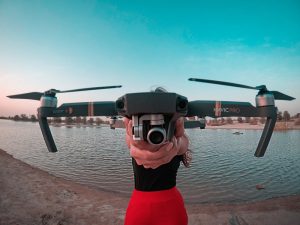 Of course, murder was largely unsolvable for thousands of years, and civilization didn’t collapse. But kill drones would create a new, asymmetrical balance of power, where single individuals could have the ability to kill millions. Today, murderers can only reach a handful of victims, but drones could enable them to kill exponentially more.
Of course, murder was largely unsolvable for thousands of years, and civilization didn’t collapse. But kill drones would create a new, asymmetrical balance of power, where single individuals could have the ability to kill millions. Today, murderers can only reach a handful of victims, but drones could enable them to kill exponentially more.
Imagine a world where criminals or terrorists could easily target one person or a thousand people at once. They could target based on race, age, sex, religion, sexual orientation, disease status, or any other variable. Mob justice might take on a new, literal meaning as popular criminal cases are decided by the public before they go to trial, leading to the defendant being summarily executed by an anonymous drone.
This tech could easily lead political institutions to or past the brink of collapse, as leaders of a certain party are targeted while those of the opposing party are allowed to live. And if such an attack were to happen, we may not know if it was perpetrated by a hostile foreign power or by a lone angry teenager living in his mother’s basement.
Anyone who writes a political opinion on Facebook would become a potential target, with facial recognition software allowing drones to seek out any individual. Dissent against authority might become a death sentence—if not from that authority itself, then from one citizen angry about another’s dissent.
Political attacks need not be so overt, either. Insect drones could repeatedly dose a politician with a slow-acting poison, causing their health to deteriorate over time. This could potentially be made to look like a natural illness.
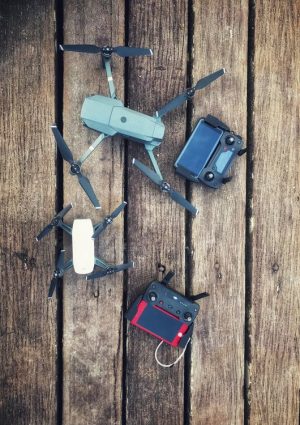 And thinking beyond stealing PIN numbers, ambitious criminals may try using bee drones to snoop on a country’s nuclear launch codes. Larger drones could land bombs in the middle of crowded stadiums or on nuclear power plants, or fly them into airplanes or cars. Drones could be weaponized to poison water supplies, contaminate products, or disperse a chemical or biological weapon.
And thinking beyond stealing PIN numbers, ambitious criminals may try using bee drones to snoop on a country’s nuclear launch codes. Larger drones could land bombs in the middle of crowded stadiums or on nuclear power plants, or fly them into airplanes or cars. Drones could be weaponized to poison water supplies, contaminate products, or disperse a chemical or biological weapon.
And again, given the anonymity of drone use, the perpetrator could be a rival state, our own government, a terrorist group, or our crazy uncle who lives in the woods. We simply would have no way to know. Unless someone publicly took responsibility, we’d have no one to blame, no one to retaliate against.
With enough effort, terrorists might even pack a suitcase full of millions of fly-sized drones carrying botulinum toxin, the lethal dose of which is about 120 nanograms.
One such suitcase could kill every person in New York City.
Countermeasures
Fortunately, most of the crimes discussed above remain speculative. Drones are currently not sophisticated enough to be widely used for most of them. And though current countermeasures are built for today’s drones instead of tomorrow’s drones, a robust drone defense industry is in its nascent stages.
Private companies are developing anti-drone guns, anti-drone lasers, and autonomous countermeasure robots. These will all need to get cheaper as drones get cheaper, but in the meantime, police are beginning to catch on to the threat that drones represent, and they are arming themselves accordingly. Even if police do catch criminal drones, they need to be able to find the criminals behind them, so drone forensics is a small but growing area of police work.
Future houses might be built with anti-drone tech running as constantly as an air conditioner, instantly disabling any drones that sneak in through a door or burrow through a window.
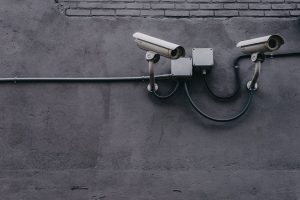 Perhaps the most realistic and effective countermeasure against malevolent drones will be defense grids of friendly drones patrolling our cities and skies. This instantly conjures images of an Orwellian police/surveillance state, and such fears may be justified, as authorities could easily abuse such a defense grid. Transparency and accountability would be paramount for such a system.
Perhaps the most realistic and effective countermeasure against malevolent drones will be defense grids of friendly drones patrolling our cities and skies. This instantly conjures images of an Orwellian police/surveillance state, and such fears may be justified, as authorities could easily abuse such a defense grid. Transparency and accountability would be paramount for such a system.
But it is a solution predicted by a number of science and fiction writers. K. Eric Drexler called such a system of friendly drones an “active shield.” In Neal Stephenson’s classic sci-fi book The Diamond Age, he envisioned a future where the air is thick with billions of drones too small for the eye to see, with armies of friendly drones constantly waging war with armies of unfriendly drones at the microscopic level. It may behoove us now to start developing countermeasures against such drones that can crawl into our ear or get breathed into our lungs.
It’s also important to remember that most drones can be hacked, so any defense grid could hypothetically turn against its owners at the drop of a hat. Active shield systems will need to be built with a decentralized design to stop this from happening. Friendly drones will need to instantly eliminate any of their hacked peers like a cancer.
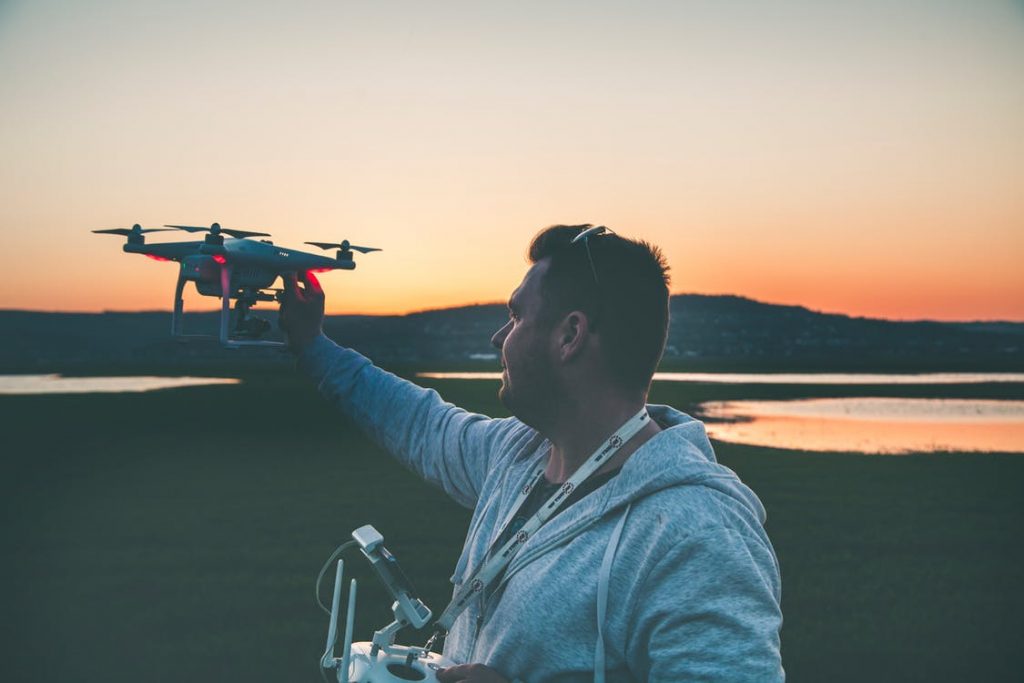 But drones can be hacked in both directions, too. Crowd participation may be an attractive countermeasure in stopping malicious drones. There are likely to remain many more good drones than bad drones, so today’s drone hobbyists could become tomorrow’s amateur crime fighters, identifying malicious drones and knocking them out of the sky.
But drones can be hacked in both directions, too. Crowd participation may be an attractive countermeasure in stopping malicious drones. There are likely to remain many more good drones than bad drones, so today’s drone hobbyists could become tomorrow’s amateur crime fighters, identifying malicious drones and knocking them out of the sky.
The most popular proposed countermeasure is a ban on autonomous weaponized drones, which numerous experts are currently advocating. While this is probably a good idea, it seems problematic as anything more than a stopgap, since one wouldn’t need the power of a state, or even a police department, to develop this technology. With enough time, a smart, dedicated small group could design it on an internet forum and then build it in a garage. Especially given the expansive D.I.Y. culture surrounding drones, it seems inevitable that someone, somewhere will develop this technology sooner rather than later.
There are also few options for enforcing a ban. Biological, chemical, and nuclear weapons production feature telltale signs that international inspectors can search for. Production of autonomous kill drones leaves no such traces. Again, these drones could hypothetically be built in someone’s garage.
It’s also worth considering how drones will interact with AI in the future, especially superintelligent AI. The direction in which we steer drone technology today will lead to the types of drones that AIs—whether friendly or not—will have access to tomorrow.
Regardless, it took fifty years from the development of the first nuclear missile until effective countermeasures against such weapons were developed, and the same must not be allowed to happen for countermeasures against drone weapons and drone crime. We must develop countermeasures in tandem with the destructive capabilities of drones. All of us—elected officials, law enforcement, and the general public—need to start planning for how to keep our society functioning through the coming era of drones.

If you enjoyed this article, you may also enjoy my book Dead Links, which portrays a society that hasn’t become a drone dystopia yet, but is starting on its way there.
This post was edited by Crystal Watanabe.




